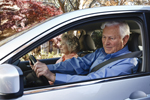Older Adult Drivers Research & Activities
Why We Do Research
 At CDC’s Injury Center, we work to translate science into effective programs and policies that prevent motor vehicle deaths and injuries, and minimize the consequences of injuries when they occur.
At CDC’s Injury Center, we work to translate science into effective programs and policies that prevent motor vehicle deaths and injuries, and minimize the consequences of injuries when they occur.
For more information on the Injury Center research, read the CDC Transportation Injury Research Priorities, as described in the CDC Injury Research Agenda.
In 2009, there were 33 million licensed drivers ages 65 and older in the United States.1
Driving helps older adults stay mobile and independent. But the risk of being injured or killed in a motor vehicle crash increases as you age. An average of 500 older adults are injured every day in crashes.2
Thankfully, there are steps that older adults can take to stay safer on the roads.
Avoidance of driving in high-risk conditions
CDC researchers found that older drivers commonly report driving avoidance during high risk conditions, such as bad weather.
Researchers studied responses to a national health survey that asked drivers about their avoidance of driving under certain conditions (e.g., at night, in bad weather, on highways). Results showed that more than half of drivers surveyed reported that they avoided driving under at least one condition. The study also foind that younger drivers report limiting driving in high risk conditions as well.
Related article
- Naumann RB, Dellinger AM, Kresnow MJ. Driving self-restriction in high-risk conditions: how do older drivers compare to others? Journal of Safety Research 2011; In press.
Exploring the relationships between walking, driving, and health
CDC collaborated with scientists at Group Health Cooperative to study the walking and driving abilities of older adults. A health survey asking questions about driving and walking habits and abilities was linked to existing health data such as medication use, health care visits and cost of care. These data allowed researchers to look at how adults restrict their driving, compare the health of drivers versus non-drivers, and explore factors that influence older adults' transportation mode choices. For example, researchers found that older adults with more confidence in their ability to walk versus drive were about 20% more likely to choose to walk to make a short trip and about 50% more likely to walk for exercise.
Related article
- Naumann RB, Dellinger AM, Anderson ML, Bonomi AE, Rivara FP, Thompson RS. Preferred modes of travel among older adults: what factors affect the choice to walk instead of drive? Journal of Safety Research 2009; 40(5): 395-398.
Developing assessment instruments for older driver capabilities

With CDC funding, researchers at the University of Michigan Transportation Research Institute developed and pilot tested a comprehensive battery of assessment tools for older drivers. Results showed that the entire battery of instruments required less than one hour to complete. Subjective statements by participants showed that the battery of instruments was acceptable, free of problems, had tasks presented in a good order, and was not too long. The authors found that the assessment battery was low-cost, transportable, easy to administer, easy for participants to complete, provided a comprehensive assessment of a person’s physical health, mental health, and driving behaviors and would serve as a valuable data collection tool for a longitudinal study of older drivers.
Related article:
- Eby DW, Molnar LJ, Shope JT, Dellinger, AM. Development and pilot testing of an assessment battery for older drivers. Journal of Safety Research 2007, Vol. 38(5):535-43.
Older adult falls while entering and exiting motor vehicles
Researchers studied the medical records of older people treated in emergency departments after being injured while getting into or out of motor vehicles. The study found that falls caused more than 41% of these injuries, which is more than any other cause.
Related Article
- Dellinger AM, Boyd RM, Haileyesus T. Fall Injuries among Older Adults from an Unusual Source: Entering and Exiting a Vehicle. Journal of the American Geriatrics Society 2008; 56 (4): 609–14.
References
- Federal Highway Administration, Department of Transportation (US). Highway Statistics 2009. Washington (DC): FHWA. [cited 2011 Feb 25]. Available from URL: http://www.fhwa.dot.gov/policyinformation/statistics/2009/dl22.cfm
- National Highway Traffic Safety Administration, Department of Transportation (US). Traffic Safety Facts 2008: Older Population. Washington (DC): NHTSA; 2009 [cited 2011 Feb 25]. Available from URL: http://www-nrd.nhtsa.dot.gov/Pubs/811161.PDF
Get email updates
To receive email updates about this page, enter your email address:
Contact Us:
- Centers for Disease Control and Prevention
National Center for Injury Prevention and Control (NCIPC)
4770 Buford Hwy, NE
MS F-63
Atlanta, GA 30341-3717 - 800-CDC-INFO
(800-232-4636)
TTY: (888) 232-6348
New Hours of Operation:
8am-8pm ET/
Monday-Friday
Closed Holidays - cdcinfo@cdc.gov




